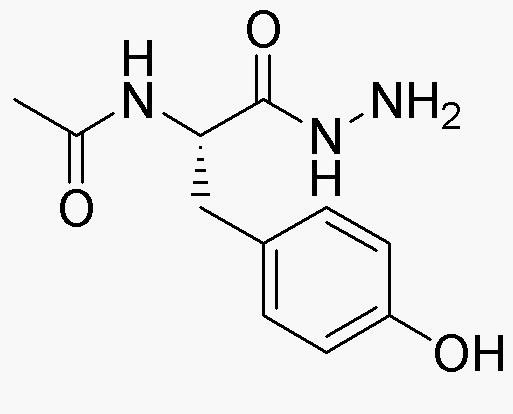Acetyl-L-tyrosine hydrazide is widely utilized in research focused on:
- Pharmaceutical Development: This compound is used in the synthesis of various pharmaceuticals, particularly those targeting neurological disorders, due to its role in enhancing neurotransmitter activity.
- Biochemical Research: Researchers employ it to study protein interactions and enzyme activities, providing insights into metabolic pathways and potential therapeutic targets.
- Food Industry: It serves as a flavor enhancer and preservative, helping to improve the taste and shelf-life of food products while maintaining safety and quality.
- Cosmetic Formulations: The compound is incorporated into skincare products for its antioxidant properties, which help protect the skin from environmental damage and promote a youthful appearance.
- Supplement Industry: It is used in dietary supplements aimed at improving cognitive function and physical performance, appealing to athletes and health-conscious consumers.
General Information
Properties
Safety and Regulations
Applications
Acetyl-L-tyrosine hydrazide is widely utilized in research focused on:
- Pharmaceutical Development: This compound is used in the synthesis of various pharmaceuticals, particularly those targeting neurological disorders, due to its role in enhancing neurotransmitter activity.
- Biochemical Research: Researchers employ it to study protein interactions and enzyme activities, providing insights into metabolic pathways and potential therapeutic targets.
- Food Industry: It serves as a flavor enhancer and preservative, helping to improve the taste and shelf-life of food products while maintaining safety and quality.
- Cosmetic Formulations: The compound is incorporated into skincare products for its antioxidant properties, which help protect the skin from environmental damage and promote a youthful appearance.
- Supplement Industry: It is used in dietary supplements aimed at improving cognitive function and physical performance, appealing to athletes and health-conscious consumers.
Documents
Safety Data Sheets (SDS)
The SDS provides comprehensive safety information on handling, storage, and disposal of the product.
Product Specification (PS)
The PS provides a comprehensive breakdown of the product’s properties, including chemical composition, physical state, purity, and storage requirements. It also details acceptable quality ranges and the product's intended applications.
Certificates of Analysis (COA)
Search for Certificates of Analysis (COA) by entering the products Lot Number. Lot and Batch Numbers can be found on a product’s label following the words ‘Lot’ or ‘Batch’.
*Catalog Number
*Lot Number
Certificates Of Origin (COO)
This COO confirms the country where the product was manufactured, and also details the materials and components used in it and whether it is derived from natural, synthetic, or other specific sources. This certificate may be required for customs, trade, and regulatory compliance.
*Catalog Number
*Lot Number
Safety Data Sheets (SDS)
The SDS provides comprehensive safety information on handling, storage, and disposal of the product.
DownloadProduct Specification (PS)
The PS provides a comprehensive breakdown of the product’s properties, including chemical composition, physical state, purity, and storage requirements. It also details acceptable quality ranges and the product's intended applications.
DownloadCertificates of Analysis (COA)
Search for Certificates of Analysis (COA) by entering the products Lot Number. Lot and Batch Numbers can be found on a product’s label following the words ‘Lot’ or ‘Batch’.
*Catalog Number
*Lot Number
Certificates Of Origin (COO)
This COO confirms the country where the product was manufactured, and also details the materials and components used in it and whether it is derived from natural, synthetic, or other specific sources. This certificate may be required for customs, trade, and regulatory compliance.


